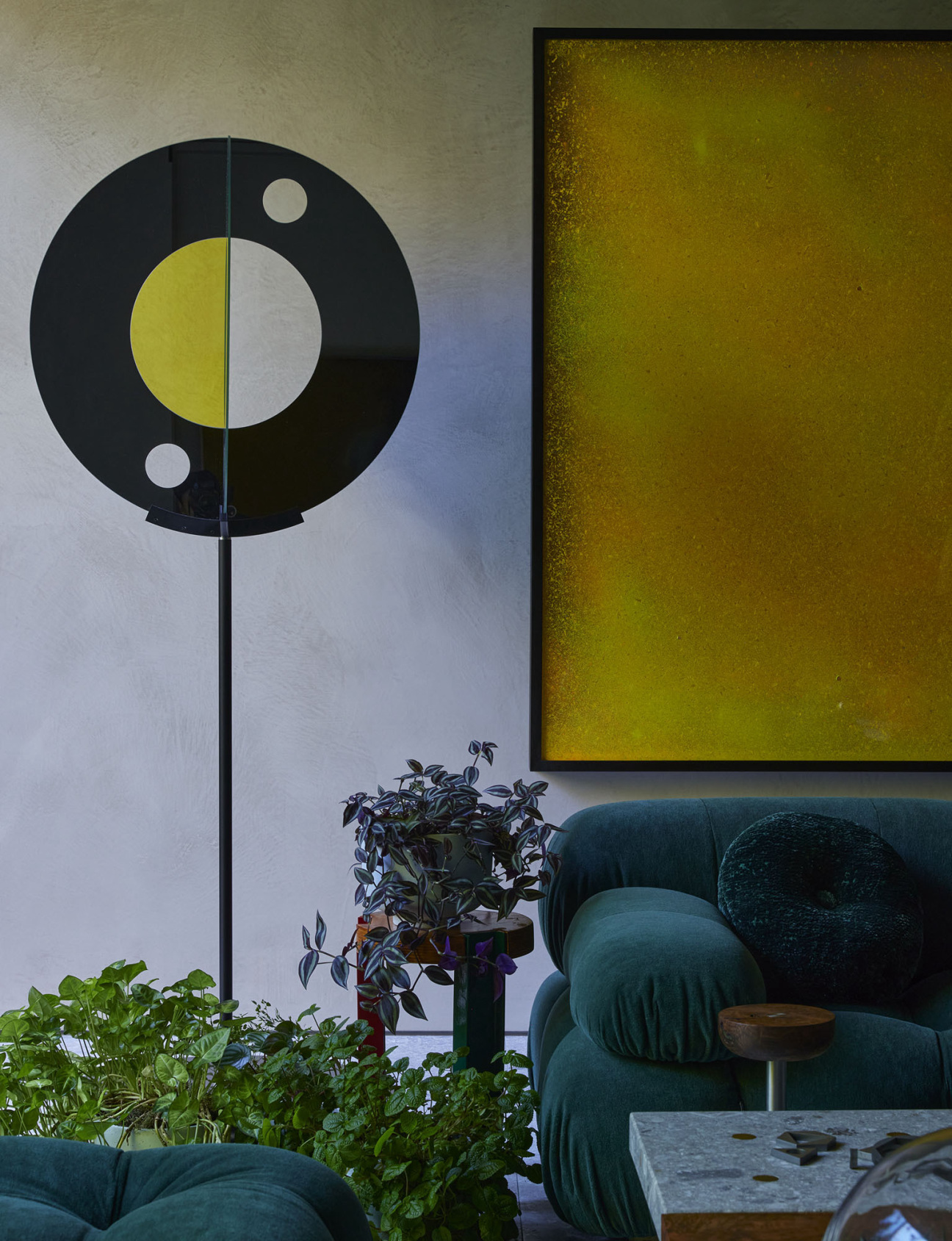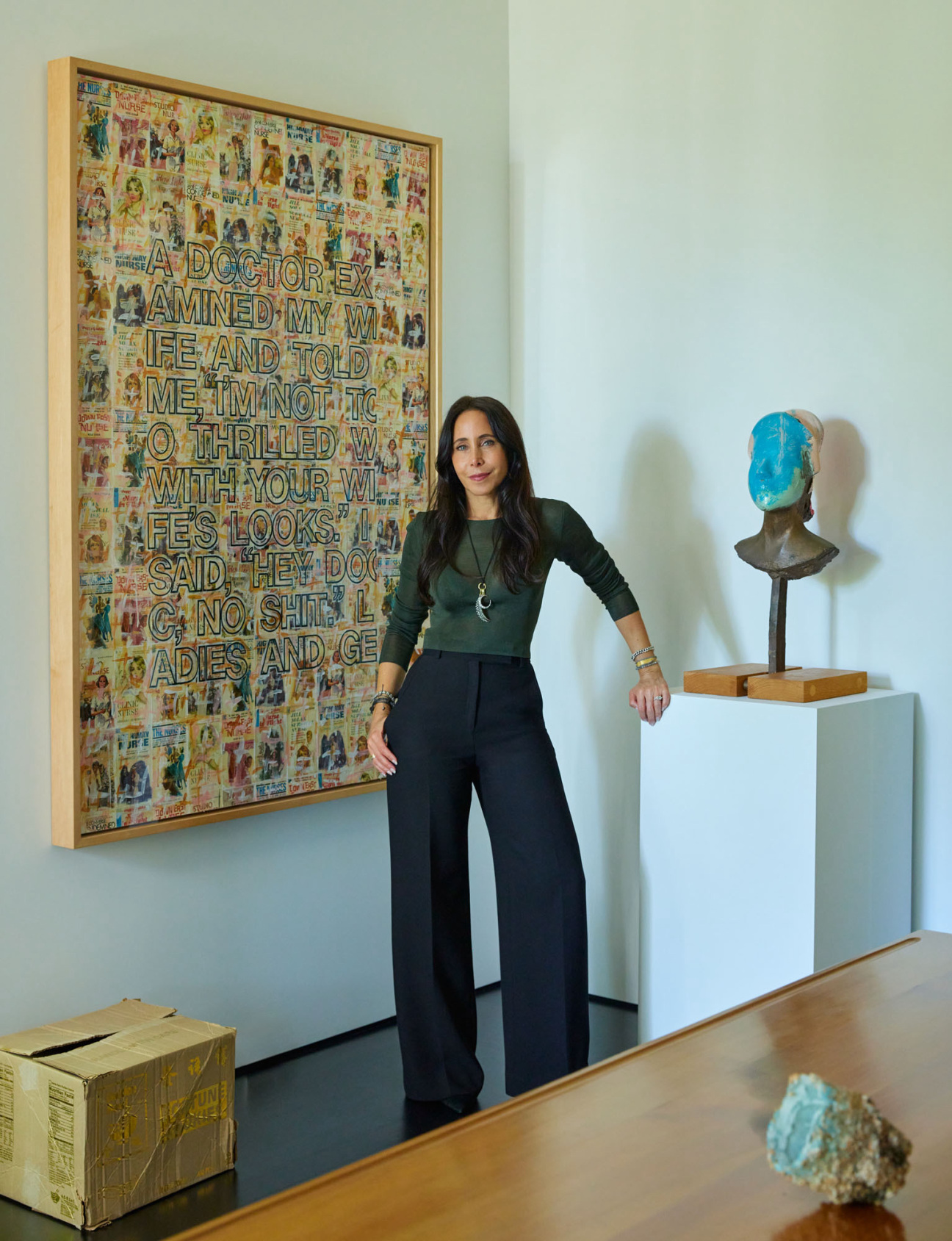
Abigail Turin and her husband, Jonathan Gans, were raised to be art lovers, but one fateful evening turned them into collectors. During a party thrown by patrons Norah and Norman Stone, the couple found themselves enamored with the hosts’ art curation and seated beside their advisor, Thea Weistrich. While Weistrich got them started on their journey, the pair's growing collection is now overseen by advisory Modica Carr. “There is a real radicality to their vision,” Suzanne Modica says of the couple’s artistic preferences. “They don’t make obvious choices. It is tempting to be lulled by the idea of minimalism, but in fact everything they choose has a sense of materiality and texture.”
The same depth is true of Turin’s taste in architecture and design—exemplified in decades of work at Kallos Turin, her international, award-winning firm that she co-founded with Stephania Kallos. Turin manages the San Francisco branch, between meetings for SFMOMA and the Whitney Museum, where she chairs the Architecture and Design Accessions Committee and sits on the National Committee, respectively. Known for her distinct approach to minimalism, Turin’s projects, which range from residential to retail, strike a singular stylistic contrast between the simplicity of design and its sense of whimsy, a signature that transcends into her art curation. Below, Turin shares with CULTURED how she maintains that classic Californian balance in her own home.
What do you think makes the San Francisco art scene distinct?
The scene feels intimate—most collectors and gallerists know each other well, but it also has a surprisingly global outlook. Collectors tend to be both serious and studious. SFMOMA is also central for many collectors, and it is a hub for us as well. The Architecture and Design Department is particularly strong at the museum and has been a big part of our interest in collecting design.

Where does the story of your personal collection begin?
My husband, Jonathan Gans, and I were both so lucky to have been raised by people who loved and collected art. We were routinely dragged through museums as children and did the same to our daughter when she was little. But our interest in developing our own collection also stems from a specific party thrown at Stonescape by the late, great Norah and Norman Stone. Something about the bold and provocative nature of their collection and how it felt so distinctly their own peaked our interest.
At that dinner we were seated next to the Stones’s art advisor, Thea Westreich [Wagner]. Talking to Thea that night about the depth and rigor of the Stones’s process made us want to work with an advisor. We started working with Thea in 2008, along with Suzanne Modica, in her New York office. When Thea retired, Suzanne started her own firm, and we continue to work with her at Modica Carr to this day—making this a 16-year-long conversation about art.
How do you incorporate art into the home? Do you build a space around a piece, or acquire works with a setting in mind?
I find it to be limiting to buy something for an exact spot. Unless the piece is really large or complicated (light sensitive or electrified for example), we try not to purchase for specific locations. You start to think too much about art as a design element if you are buying it for a specific wall. You also lose some of the magic of installation—either with pieces being placed in unexpected ways or by discovering unintended relationships between a work and its surroundings. We try to collect design the same way—to fall in love with a designer or a piece first and only then to think about its location. In general, I would rather leave a wall bare than buy something just to fill it. I think that leads to buying fewer, better things, which is something we are working toward!
At Kallos Turin, my architecture and design practice, we routinely work with clients on their collections. We have found that even when we model specific art into a space, we (or they!) often move things around during install anyway. We have found that having the flexibility to move things around leads to a much better, more relaxed and unconventional end result.

What is the first piece you ever bought?
The first pieces we acquired were by Olafur Eliasson: a mirrored standing sculpture called Your orientation maintenance with holes and the wall work he paired with it during an installation at Tanya Bonakdar Gallery for their ADAA booth in 2008. The sculpture is in the sitting room of our new space and reflects the greenery and light from the garden. We have moved this piece around the house many times over the years and love the way it feels completely different depending on its location.
Which work in your home provokes the most conversation from visitors?
The noisiest piece in the house, Ryan Gander’s animatronic eyes that follow you through the entry while whirring and clicking, is the first one people notice. But the piece that inevitably elicits the most intense conversation is a Danh Vo installation in the powder room. Guests come back to the dinner table after a stop in the restroom wondering about the “creepy old photo of the missionaries” hung against wallpaper featuring sketches of plants. That often leads to a rather dark conversation about religious colonialism and executions.

What factors do you consider when expanding your collection?
I recently inherited some of the pieces from my parents’ collection and that has led to some really interesting pairings across decades and from divergent milieus. When we moved back into our home after the renovation, we placed a Manuel Neri bronze head from my parents next to a Richard Prince joke painting we purchased in 2008. That unexpected pairing has been a high point for me in this latest installation, and it led us to look for other conversations between works from different periods.
Which artist are you currently most excited about and why?
We have had our eye on the late Italian artist, Carol Rama, for some time and recently purchased a large work of hers from 1977 that we placed next to a Vincent Fecteau sculpture from 2019. While the concepts behind their practices are unconnected, there are aspects of the works that bring them together. Both have a kind of warped geometrical underpinning. Both employ the assemblage of everyday materials—with Fecteau’s manipulated and hidden by his use of paper mache and with Rama’s dramatically draped against the austere background. There is something magical about the conversation between these pieces.

Can you tell us about the inspirations and direction you took when renovating this property? Were there any surprising shifts along the way?
The main goal of the renovation was to create a new lower level that gave us better use of the garden. This new level is home to an office, a seating area, a cabinet of curiosities, and a wine room, but it also gave us more space and taller ceilings for art! During the project, the path down to the new space became all about the art—from a neon sign by Glenn Ligon marking the stair down, to an unexpected niche carved into the stair wall allowing us to easily rotate pieces of art and design, to tiny hidden wall drawings by local artist Léonie Guyer, to a small gallery off the hall that gave us space for larger works and site-specific installations.
The North Star of the design was to create a lower level that was architecturally more a part of the garden than a part of the historic house. The materials selected for this level all convey an earthy quality—concrete, walnut, pebbled stone, and plaster. Gray plaster walls, as opposed to the white plaster in much of the original space, distinguish this level and provide a new surface for the art that gave some of the older pieces in our collection a fresh life. The level then opens onto a lush garden that feels like an oasis within the city, with a pool punctuated by a Pedro Reyes hand sculpture at the far end that seems to be beckoning us outside.
What are the three must-see shows this month in San Francisco?
Nicole Wermers at Jessica Silverman Gallery, Elisheva Biernoff at Fraenkel Gallery, and the Shah Garg Collection at BAMPFA. Also, the opening shows at ICA SF in their new space downtown.










 in your life?
in your life?

